|
(pressing HOME will start a new search)
|
|
Field Internships for Construction Students: A Survey
- Sandra L. Weber
Members of the Construction Industry Advisory Council (IAC) at the Del E. Webb School of Construction (DEWSC) at Arizona State University (ASU) believe that field experience should be a requisite educational objective and curriculum component. Although the DEWSC faculty knows the benefits construction graduates derive from prior field experience, it was important to find out if the need for such experience was real or perceived before committing resources and making programmatic changes to include a field internship curricular component. A multi-questionnaire survey was conducted among students of the DEWSC and members of industry to determine the breadth and depth of student field experience and to determine what industry expects from DEWSC graduates. The study assessed the current field experience level of students in the program, the field construction knowledge expectations of the local construction industry, the willingness of students to participate in an internship program, and the industry’s willingness to support, through employment and remuneration, a field internship program. This paper details the process of the study, from the establishment of an IAC Task Force to the possible final DEWSC course structure and implementation strategy, and explains the current barriers to implementation.
Key Words: Advisory Council, Graduates, Student Internship, Student Employment, Construction, Industry.
Introduction
The Del E. Webb School of Construction (DEWSC) at Arizona State University (ASU) has an active Industry Advisory Council (IAC) that monitors curriculum direction by assessing student academic achievement through the part-time employment of current students and the full-time employment of graduates, and suggests changes to better align the curriculum to meet industry needs. An IAC member expressed the concern that, although their computer skills were excellent, graduates of the DEWSC program had limited field experience. Echoing a trend in engineering to hire graduates with internship or co-op experience (Rubin and Tulacz, 1995), the IAC member believed that field experience should be a requisite educational objective and curriculum component. From the time of inception of a possible field internship program to address the concern, it was believed that students who would participate in the program would be freshmen or sophomores with little educational background to support their field experience. It was believed that field experience would provide these students with valuable insights that would help them in courses they had yet to take.
The DEWSC faculty knows the benefits construction graduates derive from prior field experience; however before committing resources and making programmatic changes to include a field internship as a curricular component, they believed it was important to find out if the need for such experience was real or perceived. Although students have always been encouraged to get work experience prior to graduation, it appeared that the industry’s perception was that a significant percentage of graduating students was without field experience. Consequently, if industry perceptions were correct, a study was needed to identify available resources, to research other comparable internship programs, to design a course, and to plan its potential implementation. This paper details the process of the study, from the establishment of an IAC Task Force to the possible final course structure and implementation strategy, and explains the current barriers to implementation.
The IAC and DEWSC faculty committed to the study determined that a survey would be the only means of determining how much and what kind of actual field experience DEWSC students had. The process of determining the breadth and depth of student field experience, determining what local industry needs from DEWSC graduates, running a summer pilot field internship, and collecting feedback from both student and industry participants required the use of multiple questionnaires. The process was also the focus of meetings of an IAC Task Force designed to provide input and advice on the entire process.
This study and its questionnaire distribution was limited to students enrolled in the DEWSC graduate and undergraduate programs during 1997, members of the DEWSC IAC, and members of the IAC Construction Process Task Force.
Historical Background
The DEWSC has developed close industry ties beginning with an Industry Advisory Council (IAC) formed in 1988, an outgrowth of the Advisory Council of the Engineering Research Council, and the Alliance for Construction Excellence (ACE) that was formed in 1991(Badger and Pruitt, 1997). Both groups have helped to strengthen the program’s interactions with industry, and provided vital support in helping the program gain academic preeminence. The benefits of having graduates with field experience extend to the industry in ways other than new employees with incoming job knowledge. The DEWSC Industry Advisory Council recognizes, as do others (Rubin and Tulacz, 1995; Physics Today, 1991, and Reester, 1995) that student interns provide their employers with alternate methods of recruiting and potential opportunities for technology transfer.
The DEWSC currently has two levels of established internship programs. The first is a managerial internship for upper division students with a minimum 2.75 GPA. Students are assigned duties in estimating, scheduling, marketing, and the like. They and the intern’s sponsoring company enter into an agreement that requires the student to participate in several of the company’s operations and prepare a culminating report. This course has been a program component (technical elective) since 1994, and has recently (fall 1996) become a mandatory component of the residential program option.
The second internship program places students in several governmental agencies. Seniors can serve as interns in the Arizona State Legislature, the Registrar of Contractors Office, the Department of Administration, and for many local municipal agencies such as the City of Scottsdale. Some of these internships are full time and some are competitively won through scholarship and personal interviews.
The ASU construction program, however, has not had a required or optional field internship program. The Construction Process Task Force was established in September 1996 to help respond to a push for a DEWSC field internship program. The 30-member task force, 20 from industry and 10 faculty representatives, held four meetings during 1997 alone to discuss the scope of the internship program, the survey results, and the pilot internship program. The task force will continue during 1998 and has no planned sunset date as yet. Some of the common questions the Task Force has are what are other schools doing about a field internship program, and how are they doing it.
Of the 81 member schools of the Associated Schools of Construction (ASC), approximately 10% have field internship programs. A common element of all internship programs, whether those of the ASC schools or others, is administrative coordination. Some programs, such as that at Pratt Institute, according to Mary Matthews, Chair of their Construction Management, have an ad hoc approach to internship administration, letting students work with individual faculty to arrange and coordinate internships. Some other programs, like the one at Colorado State University, have raised funds for a full-time internship coordinator (CSU, 1997). Others, like Purdue University’s Construction Engineering and Management program, have a full-time Internship Director position (12-month) that dedicates 60% of the annual effort to coordinating and administering the internship process (Tener, 1996).
Some of the programs receive funding from the industry as an administrative surcharge for the student employees. Others have solicited endowments for their coordination efforts, while still others have no additional administrative costs (Tener, 1996, CSU, 1997).
Assessment Survey
Students
In the spring of 1997 a survey of the students of DEWSC was conducted to determine what percentage had limited (less than 6 months to one year) construction field experience (Appendix A). The survey was intended to reach a broad cross-section of the students in the department, from freshmen through graduate students. To achieve this broad coverage, surveys were distributed in two courses from each academic-year category. The survey asked students first for basic demographic data that related to their school year, anticipated graduation date, and major. Thus far, only the school year results have been incorporated into the data analysis. The survey also asked students for descriptions of prior field experience and whether they wanted to participate in a field internship and if such an internship should be mandatory.
Findings
A total of 182 responses was obtained from the reported 322 students enrolled in the various curricular options in the DEWSC. Of those enrolled, 248 (77%) were undergraduates and 74 (23%) were graduate students. Therefore, the sample of returned questionnaires represented 57% of the registered students in the program. The responses were from 133 undergraduates, representing 53% of those enrolled, and 49 graduate students, or 66%, of those enrolled.
The results showed that 84 or 48% of the 176 students responding had less that one year of field experience (Figure 1) primarily in commercial construction (48 of 134 responding or 35.8%, Figure 2) in management (45 of 180 responses or 25%) or craft labor (28 or 16%) positions (Figure 3). When the DEWSC seniors were extracted, their response group alone showed 22 or nearly 40% with less than one year’s field experience and 16 or 29% with 6 months or less of experience (Figure 4). These findings suggested that, if nearly half of the DEWSC students had less than one year of field experience, the industry perception might be accurate.
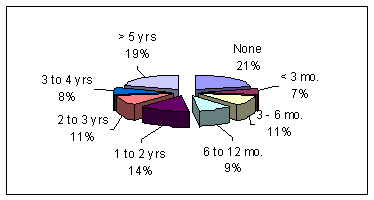 |
| Figure 1. Reported student field experience – initial survey |
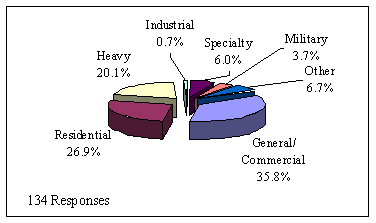 |
| Figure 2. Student work experience by industry type – initial survey |
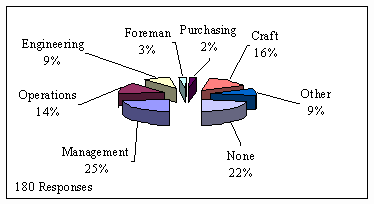 |
| Figure 3. Student field experience by job function – initial survey |
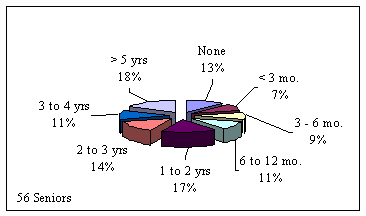 |
| Figure 4. Senior student field experience – initial survey |
Follow-On Work
The department regularly requires new students meeting with the School’s Academic Advisor to complete the Field Experience Questionnaire. During the fall 1997 semester, 22 new student questionnaires were collected. The figures that follow describe the statistics that relate to this newly collected information.
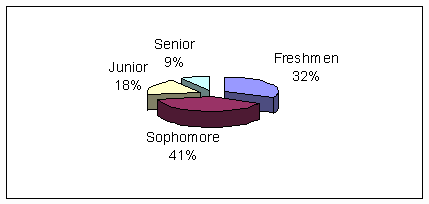 |
| Figure 5. Student response distribution beginning fall 1997 |
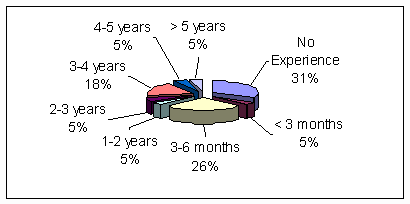 |
| Figure 6. level of newly enrolled students |
It is clear from Figure 6 that the number of students with limited experience (62%) is larger in this group than in the initial survey.
Industry
A survey that originated in the IAC Task Force group asked company representatives of local, high-level industry employers for demographic data such as title and company classification and specialty. After providing demographic data, the representatives were asked to describe field internship components, duration, outcome assessment methods, pay scale, and if they would be willing to contribute to the administrative expense of such a program (Appendix B). A total of 25 industry responses were received through April 1997. The majority of responses came from commercial contractors (40%, Figure 7). One of the questions asked respondents to give the names of others who were in a position to make comments for their companies. This produced a somewhat larger pool of responses than that which could have been obtained via the task force alone.
The data were analyzed to determine if different industry groups had different entry-level construction requirements. The results showed that specialty contractors on the whole were more interested in interns participating in craft labor activities and were also willing to pay interns higher hourly wages than were their general building colleagues.
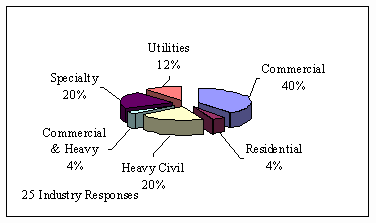 |
| Figure 7. Industry respondents’ fields of construction |
Findings
When asked to indicate whether or not any of the 13 field experience components (see Table 1) should be a part of the internship, respondents showed that they felt strongly that areas like subcontract administration should be included; 84% (21) responded "yes." Conversely, 84% (21) of the respondents felt that equipment operation should not be included. Table 1 shows the industry’s response to the 13 predefined areas. Additionally, respondents were asked to add other areas they believed were important to the field internship experience. These suggestions were quality control functions, request for information, safety, field quantity take-off, scheduling, checking submittals and shop drawings, sales, land acquisition, field inspection, document control, expediting, CAD drawing, estimating, presentation skills, meeting minutes, and daily logs. These additions were from 10 of the 25 respondents (40%). Although these added responses gave more insight into field operational expectations, some were beyond the educational level of the proposed student field interns.
Table 1
Industry initial responses
|
Field Internship Component |
Yes |
No |
Missing |
|
As-built Drawings |
14 |
10 |
1 |
|
Field Change Orders |
17 |
7 |
1 |
|
Equipment Operation |
3 |
21 |
1 |
|
Productivity Studies |
11 |
12 |
2 |
|
Subcontract Administration |
21 |
3 |
1 |
|
Subcontract Preparation |
12 |
12 |
1 |
|
Materials Testing |
12 |
12 |
1 |
|
Mat’ls Handling/ Inventory |
11 |
13 |
1 |
|
Assistant Office Engineer |
15 |
9 |
1 |
|
Punchlist |
16 |
8 |
1 |
|
Field Survey/Layout |
12 |
12 |
1 |
Pilot Internships Summer 1997
A total of nine students ultimately participated in the pilot-summer-field-internship program, working for five companies. Two of the companies were specialty contractors, one utility, one commercial contractor, and one combined commercial and heavy contractor. The experiences of eight of the nine interns were successful for both student and company. Students were asked to keep a daily log of their experiences and to take a weekly videotape of their project. They were also asked to write a thank you letter to their employer at the end of the summer. No course was taken, nor was any credit given the students, although the students were paid for their time. Payment ranged from $8 to $10 per hour and was determined by each company individually. Students were sophomores to seniors. Little coordination was done once the company and the student agreed to employment; however, getting an agreement was not an easy task. One contractor never got a student intern after several attempts. Ten or eleven other students who were not a part of this pilot study participated in field internships during the same summer that the study was conducted.
Results
Students
Exit interviews in the fall with seven of the nine participants demonstrated that five of the seven (71.4%) felt that the internship was "very valuable" while the remainder felt it was only "valuable." The students overwhelmingly believed that the field internship should take place between the sophomore and junior year (71.4% or 5 of 7), and all felt that the continuity of the summer (full-time work) was most appropriate in contrast to part-time work during a semester, when their focus would be less specific.
As shown in Figure 6, the support for the need for an internship program appears to be growing. This conclusion is further borne out by a survey of the 26 graduating seniors in the Fall 1997 (Appendix C). That survey produced 16 responses and showed that 14 of the 16 (87.5%) respondents had significant (more than 12 months) field experience. The other two had from 3 to 6 months of field experience. Moreover, all participants of the pilot-internship exit interview felt that field experience should be mandatory for all program graduates. In contrast, only 57% of the spring 1997 initial survey respondents believed the internship should be mandatory.
Industry
Seven of the industry representatives responded to a survey of the outcome assessment of their student interns. Respondents were asked to describe the students’ overall responses to performance expectations and outcomes and then to 14 performance measures. The performance measures were:
| Ability to make job-related decisions | |
| Accepts change | |
| Accepts direction | |
| Accepts responsibility | |
| Attendance | |
| Attitude | |
| Dependability | |
| Initiative | |
| Knowledge of the work | |
| Leadership | |
| Planning and organization skills | |
| Quality of work | |
| Quantity of work | |
| Safety practices |
In addition, the representatives were asked to comment on the students’ strengths and their opportunities for improvement, along with an overall appraisal. In all but the one unsuccessful internship experience employers felt that the students met their expectations.
The IAC
Because of the overall success of the process, in November 1997 a post-pilot study questionnaire (Appendix D) was distributed to members of the Industry Advisory Council (IAC), which asked them to respond to a brief four-question survey to determine whether they would participate in a summer 1998 internship program. At the time of this writing, 13 questionnaire responses have been received from IAC members who attended the November meeting. The IAC members were asked to review an attached list of company responsibilities (Appendix E) and respond to four main questions. Six of the nine (66.7%) individuals responding to the question were Construction Process Task Force members. With regard to two of the four questions, all 13 of the respondents expressed a willingness to hire a summer intern and mentor them in 1998. In answer to the third question, 10 of the 13 (77%) respondents volunteered to help coordinate the summer field internship process. The final question was open-ended, asking respondents for comments on the internship process thus far. Sixty-seven percent (4 of 6) of the comments provided requested the expansion of the program. In other words, the industry wanted more students to participate; they are willing and able to employ them.
The Course
Basing its decision on several factors, the department has tabled the implementation of an actual field internship course. Although it is clear that many students would benefit from a field internship experience prior to graduation, resources, implementation mechanics, and market mechanics have continued to keep the faculty from making a commitment to the curricular change required to accommodate this component.
Based on the current program size, 35 to 45 internships per year would be needed to accommodate the DEWSC students. Although 57% of the initial industry survey respondents said that they would contribute $0.50 or more per student intern work hour, the school has decided to add a line item to the current capital campaign to endow an administrative internship coordinator position. Until the campaign goals are realities, the DEWSC faculty will continue to offer internships in limited numbers, relying on volunteer industry coordination for help beginning in the summer of 1998.
Issues that remain to be resolved upon the conclusion of the capital campaign include whether the course should be mandatory or optional. Although a mandatory requirement seems most beneficial to students, concerns have been expressed as to how problems like limited intern opportunities and previous industry experience would be handled. Even if students were required to find their own internship slots, the availability of positions is likely to change as the current construction boom cycles to a more restricted market. There are also concerns about limits in certain focus areas like residential or specialty construction.
Programmatic additions would require the deletion of a corresponding credit component to remain within the college mandated cap of 128 credit hours, or making the program a non-credit course. Although the non-credit option is not distasteful to the students who participated in the summer ’97 program nor to the faculty, similar examples would have to be found within the college, or at least within the university to bolster the case for this course.
Some faculty also feel that if the market, the construction employers, begins hiring only students with prior field experience, the students will work to get the experience on their own without structured faculty or program involvement. Currently, both because of the strong construction market and the school’s reputation, part-time construction jobs (not craft labor) are plentiful. Students not taking advantage of this situation are doing themselves a disservice. However, as many of the DEWSC students are self-supporting, frequently they find other, more lucrative work, in less professionally rewarding areas.
The scope of the field internship component has yet to be resolved, but it is believed that as a first effort the course would be for one summer only if it were mandatory. Some industry professionals, however, believe that there should be multiple field experiences for students, and that one summer does not allow enough time for such experiences. In comparison, the Purdue CEM program requires its students to participate in three 12-week internships, while the Colorado State program seems to require a semester and a summer of internship for graduation (Tener, 1995 and CSU, 1997).
It is believed that the course might be better positioned between the sophomore and junior years, instead of the original plan for inclusion between the freshman and sophomore years. However, no commitment to placement within the curriculum has been reached. Implementation will be the subject of on-going IAC Task Force members and DEWSC faculty discussions until funding has provided a full-time coordinator.
Conclusion
This work has helped the DEWSC develop several information gathering and assessment tools that will benefit the program as it moves forward. Tracking industry needs and student accomplishments are important to the success of the DEWSC program. On-going work to refine the method of distribution and collection of these tools is also planned.
The DEWSC plans to continue to run the managerial and government internships currently in place and, while gathering funding for an internship coordinator, will continue to try to coordinate summer field internships on a limited pilot-program basis. A continuing effort is planned to track graduates and to assess their field experience prior to graduation. The DEWSC continues to strive for excellence, and this effort is a part of its plan.
Acknowledgements
A College of Engineering and Applied Sciences Faculty Educational Improvement Grant-in-Aid and supplemental DEWSC departmental funding provided the funds to support this study. The author appreciates these financial contributions. Additional thanks go the IAC and its Construction Process Task Force members for their help and guidance.
References
Badger, William & Pruitt, J. Doug. (1997). The Industry Advisory Council and the Del E. Webb School of Construction. ASU College of Engineering and Applied Sciences, Arizona State University, Tempe, AZ.
Constructing the Future, Managing Our Destiny. (1997). Colorado State University, Dept of Industrial Science, Fort Collins, CO.
"Industrial internships provide physics students with valuable experience." (1991, September). Physics Today, 44, 93.
Reester, Keith A. Jr. (1995, January). "Using an intern to fill your needs." Public Works. 126, 50.
Rubin,Debra K. & Tulacz,Gary J. (1995). "Outlook good for class of ’95." ENR. 234 (24), 13-14.
Tener, Robert K. (1996). "Industry-university partnerships for construction engineering education." Journal of Professional Issues in Engineering Education and Practice. ASCE, 122 (4), 156-162.
Appendix A. Student Field Experience Questionnaire
1. What is you current class standing?
01 › Freshman
02 › Sophomore
03 › Junior
04 › Senior
05 › Graduate
2. What is your expected semester/year of graduation?
06 › Fall 09 › 1997 12 › 2000
07 › Spring 10 › 1998 13 › 2001
08 › Summer 11 › 1999 14 › 2002
3. Which category best indicates your selected field of specialization?
15 › General Building Construction
16 › Residential Construction
17 › Heavy Construction
18 › Military Construction
19 › Specialty Construction
20 › None
4. Which categories best describes your primary job function? Positions below are examples of titles within each category. If your exact title is not shown, check the category that best indicates the majority of your field construction experience and/or the largest company that you worked for.
21 › Management Positions – Project Manager. General Supt., Engineering Manager,
Discipline Supt. (e.g., Civil, Mech., Concrete), Contract Manager, Labor Relations Manager.
22 › Operations Positions – Office Estimator, Schedule Eng., Cost Eng., Field Estimator.
23 › Engineering Positions – Construction Eng., Civil Eng., Mech. Eng., Field Eng., Project
Eng., Resident Eng., Civil Surveyor.
24 › Foreman Positions – Craft Supt., Craft Foreman.
25 › Purchasing Positions – Contract/Subcontract Adm., Field Expediter, Purchasing Agent.
26 › Craft Positions – Carpenter, Laborer, Operator, Ironworker,
27 › Other positions (specify) _________________________________
28 › None
5. Which category best indicates your cumulative construction field experience?
29 › Less than 3 months
30 › 3 to 6 months
31 › 6 to 12 months
32 › 1 to 2 years
33 › 2 to 3 years
34 › 3 to 4 years
35 › more than 5 years
36 › None (If this is your answer, Go to Question 8)
6. Which category best describes your company’s primary type of construction? Check the one category that indicates the majority of your field construction experience and/or the largest company that you worked for.
37 › General Building Construction
38 › Residential Construction
39 › Highway and Heavy Construction
40 › Heavy Industrial Construction
41 › Specialty Construction
42 › Military Construction
43 › Other
7. What category best describes your company’s annual contract/sales volume? Check the one category that indicates the majority of your field construction experience and/or the largest company that you worked for.
44 › More than $50 million
45 › $25+ to $50 million
46 › $10+ to $25 million
47 › $5+ to $10 million
48 › $1+ to $5 million
49 › $500+K to $1 million
50 › $100+ to $500 thousand
51 › Less than $100,000
8. Would you be interested in a field internship?
52 › Yes
53 › No
9. Should it be mandatory?
54 › Yes
55 › No
10. Who would you like to work for? What kind of company? (Type of construction).
__________________________________________________________________
11. Additional information: (e.g., what types of activities should be part of the field internship?)
__________________________________________________________________
__________________________________________________________________
__________________________________________________________________
__________________________________________________________________
Appendix B. Industry Needs Survey
Name: _______________________________ Title: ______________________
Company: ____________________________________________________________
Company Classification: Commercial/Gen’l Bldg Residential Heavy/Civil
Specialty (which specialty?) ____________________ Industrial/Clean Room
Please answer the following questions with regard to the field internship course content:
- How long should the internship be?
Summer session
5 weeks or 8 weeks
Regular semester session 16 weeks
- What components should each student experience?
| Physical labor working with a crew or crews | |
| Working as an assistant field engineer | |
| Preparing As-built drawings | |
| Equipment operation | |
| Productivity studies | |
| Subcontract administration | |
| Subcontract preparation | |
| Materials testing | |
| Maters handling/inventory | |
| Working as an assistant office engineer | |
| Punchlist | |
| Field surveying/layout | |
| Please list additional areas you would suggest as a field experience for these students at the bottom of the page |
| Report or questionnaire completed by the field supervisor | |
| Report prepared by the student on one or more aspects of the experience | |
| Visits to the job site by administrative faculty to conduct in-person interviews during the field internship | |
| Other (specify) |
| No pay - $8-$10 | |
| $10-$12 - More than $12 |
| None - $0.50 | |
| $1.00 - More than $1.00 |
| Estimating | |
| Project management | |
| Safety | |
| Labor relations | |
| Project case studies | |
| Mechanical and/or Electrical | |
| Foundations |
Please provide the names and phone numbers of other construction company managers who are in a position to make commitments for their company regarding internships.
Would you be willing to provide an internship position this summer?
Appendix C. Graduating Seniors Survey: Field Internship Questionnaire
Please list all of your construction FIELD experience below.
Dates of Comm (C), Hvy (H)
Service Positions Company Name Res (R), or Spec (S)
_________ __________ _____________________________ C/R/H/S
_________ __________ _____________________________ C/R/H/S
_________ __________ _____________________________ C/R/H/S
_________ __________ _____________________________ C/R/H/S
Do you have a job after graduation? Y or N
With what company?_________________________________
Title of your new position______________________________
Appendix D. Construction Industry Survey (Post-Pilot Summer Internship)
Please review the enclosed list of company expectations before answering the questions below.
Name: _______________________ Company: _______________________
Phone Number: ______________ Task Force Member? Yes or No
1. Would you be willing to assist in coordinating the selection and placement of students for summer internship positions? Y or N
2. Would you or your company want to hire a field intern for the summer? (assuming that your work load could support it) Y or N
3. Would you be willing to assign a mentor/coordinator to the student you employ? Y or N
4. Do you have any suggestions for improvements to the field internship process?
Appendix E. Company Responsibilities
1. The company coordinator will designate a task instructor who has overall responsibility for overseeing the development of the intern in specific tasks. The task instructor is expected to advise, counsel, and instruct the intern and, in addition, establish and maintain a learning environment that challenges the intern’s intellect and problem-solving abilities.
2. The company coordinator and intern will hold at least one conference during the assignment.
3. The company coordinator will be asked to complete an evaluation of the intern at the end of the internship period (a copy will be provided to the faculty advisor).
4. Neither the company nor the student intern is committed to offering/accepting full-time employment with the company upon completion of the internship or graduation.
5. The company is not responsible for paying the student while he/she performs
reporting activities like daily logs or video taping. The company is not expected to provide any of the materials, equipment, or supplies needed to fulfill these student requirements.
